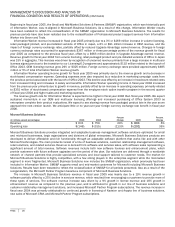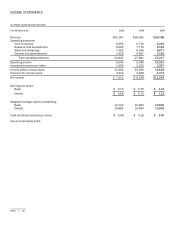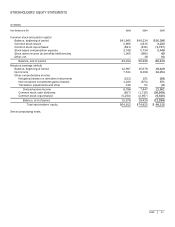Microsoft 2005 Annual Report Download - page 37
Download and view the complete annual report
Please find page 37 of the 2005 Microsoft annual report below. You can navigate through the pages in the report by either clicking on the pages listed below, or by using the keyword search tool below to find specific information within the annual report.
MANAGEMENT’S DISCUSSION AND ANALYSIS OF
FINANCIAL CONDITION AND RESULTS OF OPERATIONS (CONTINUED)
PAGE 36
and business outlook for the investee, including industry and sector performance, changes in technology, operational and
financing cash flow factors, and rating agency actions. Once a decline in fair value is determined to be other-than-temporary, an
impairment charge is recorded and a new cost basis in the investment is established. If market, industry and/or investee
conditions deteriorate, we may incur future impairments.
SFAS No. 142, Goodwill and Other Intangible Assets, requires that goodwill be tested for impairment at the reporting unit
level (operating segment or one level below an operating segment) on an annual basis (July 1 for us) and between annual tests
if an event occurs or circumstances change that would more likely than not reduce the fair value of a reporting unit below its
carrying value. These events or circumstances could include a significant change in the business climate, legal factors,
operating performance indicators, competition, sale or disposition of a significant portion of a reporting unit. Application of the
goodwill impairment test requires judgment, including the identification of reporting units, assignment of assets and liabilities to
reporting units, assignment of goodwill to reporting units, and determination of the fair value of each reporting unit. The fair
value of each reporting unit is estimated using a discounted cash flow methodology. This requires significant judgments
including estimation of future cash flows, which is dependent on internal forecasts, estimation of the long-term rate of growth
for our business, the useful life over which cash flows will occur, and determination of our weighted average cost of capital.
Changes in these estimates and assumptions could materially affect the determination of fair value and/or goodwill impairment
for each reporting unit.
We account for research and development costs in accordance with several accounting pronouncements, including SFAS No.
2, Accounting for Research and Development Costs, and SFAS No. 86, Accounting for the Costs of Computer Software to be
Sold, Leased, or Otherwise Marketed. SFAS No. 86 specifies that costs incurred internally in researching and developing a
computer software product should be charged to expense until technological feasibility has been established for the product.
Once technological feasibility is established, all software costs should be capitalized until the product is available for general
release to customers. Judgment is required in determining when technological feasibility of a product is established. We have
determined that technological feasibility for our software products is reached shortly before the products are released to
manufacturing. Costs incurred after technological feasibility is established are not material, and accordingly, we expense all
research and development costs when incurred.
The outcomes of legal proceedings and claims brought against us are subject to significant uncertainty. SFAS No. 5,
Accounting for Contingencies, requires that an estimated loss from a loss contingency such as a legal proceeding or claim
should be accrued by a charge to income if it is probable that an asset has been impaired or a liability has been incurred and
the amount of the loss can be reasonably estimated. Disclosure of a contingency is required if there is at least a reasonable
possibility that a loss has been incurred. In determining whether a loss should be accrued we evaluate, among other factors, the
degree of probability of an unfavorable outcome and the ability to make a reasonable estimate of the amount of loss. Changes
in these factors could materially impact our financial position or our results of operations.
SFAS No. 109, Accounting for Income Taxes, establishes financial accounting and reporting standards for the effect of
income taxes. The objectives of accounting for income taxes are to recognize the amount of taxes payable or refundable for the
current year and deferred tax liabilities and assets for the future tax consequences of events that have been recognized in an
entity’s financial statements or tax returns. Judgment is required in assessing the future tax consequences of events that have
been recognized in our financial statements or tax returns. Variations in the actual outcome of these future tax consequences
could materially impact our financial position, results of operations, or cash flows.
We account for stock-based compensation in accordance with the fair value recognition provisions of SFAS No. 123,
Accounting for Stock-Based Compensation. Under the fair value recognition provisions of SFAS No. 123, stock-based
compensation cost is measured at the grant date based on the value of the award and is recognized as expense over the
vesting period. Determining the fair value of stock-based awards at the grant date requires judgment, including estimating the
expected term of stock options, the expected volatility of our stock and expected dividends. In addition, judgment is also
required in estimating the amount of stock-based awards that are expected to be forfeited. If actual results differ significantly
from these estimates, stock-based compensation expense and our results of operations could be materially impacted.
























